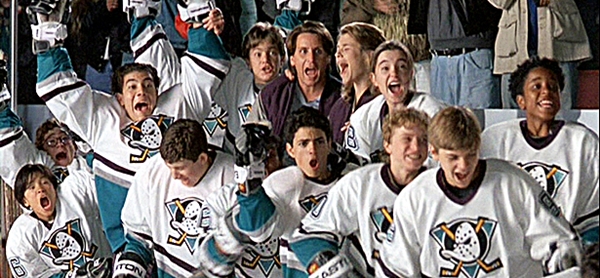MN’s ‘Mighty Ducks’ legislation could be costly for local rinks

THEY WANT TO BUILD IT: Minnesota is debating a bill calling for millions in taxpayer funding, known as Mighty Ducks funding, to build and improve ice arenas in the state.
By Tom Steward │Watchdog Minnesota Bureau
PLYMOUTH, Minn.— Coming soon to an arena near you: “Mighty Ducks 2!”
Disney filmed the hockey classic in Minnesota, and now state lawmakers are pushing a legislative sequel.
Some legislators want to re-enact the 1994 “Mighty Ducks” legislation providing public funding to help build 61 new ice sheets and dozens of new arenas statewide.
“It’s still popular when you say that, it resonates with watching it, whether it’s “Mighty Ducks 1 or 2″ ” said Dean Mulso, recreation facilities manager for the city of Burnsville. “It’s funny how they keep using that term for the legislative piece. But I think it sticks out then.”
The proposed $8-million production budget for “Mighty Ducks 2” under S.F. 2652 falls short of the $18 million appropriated for the state’s first Ducks release. But then, it’s a sequel with financial backing cobbled together from Minnesota taxpayers. A bill in the state House calls for $5 million in Mighty Ducks funding. Both measures would provide matching funds to replace ice-edging equipment to improve indoor air quality.
The antagonist behind “MD2” turns out to be an Environmental Protection Agency regulation requiring rinks to phase out the ozone-depleting refrigerant R-22 in favor of alternatives such as ammonia.
“If it’s released in the atmosphere ammonia only lasts for 72 hours, while R-22 refrigerant lasts for 12 years in the atmosphere,” said Bill Abel, ice center manager for Plymouth.
Over the next few years about half of the state of hockey’s 240 aging ice arenas could need millions to comply.
TOUGH ECONOMIC ENVIRONMENT FOR SKATING: Facing off against a $1.5 million bill to replace ozone-unfriendly refrigerant, this Twin Cities ice rink closed for good after the season. Meet Minneapolis photo.
“If every ice rink that needed to change out or to explore different options, if we all tried to do it right now this year, there’s not enough refrigeration companies and skills and people in the Twin Cities or even statewide that could do it all in one year,” said Craig Flor, president of the Minnesota Ice Arena Managers Association, who’s overseeing a $3.5 million upgrade as director of the Mariucci and Ridder Ice Arenas at the University of Minnesota.
Many city-run rinks already operate at a loss often running into six figures. The suburb of Edina, for example, transfers about $360,000 from its liquor and construction funds to offset normal annual operating losses at Braemar Arena.
“The challenge of managing a municipal ice arena is a tough one. If I demanded that Susie Miller (general manager) pay 100 (percent) of her annual operating and capital costs with ice rental revenues, she’d have to charge somewhere in the neighborhood of $300/hour for ice rental in a $200/hour market,” said Scott Neal in his city manager blog recently.
An expensive leak led Edina to go Freon-free this fall, for about $750,000.
“We caught the leak fairly quickly, but we still lost 1,500 pounds of R22 at the cost of $12.65 per pound. After labor to stop the leak and labor to install the R22, it cost Braemar Arena more than $26,000,” Miller, general manager of Braemar Arena, wrote on the city website. “Imagine if … we did not catch it and lost all 8,000 pounds. It would have cost more than $100,000. Thus, the need to fast track the change out.”
Although its 17-year-old Freon-based system still works well, nearby Plymouth also plans to swap out two more ice sheets. Part of an overall $1.6 million renovation, the switch to a more energy-efficient ammonia-based replacement will cost a cool $1 million.
One of the rare local governments to turn an annual profit of $150,000 to $300,000 on its arena, Plymouth nevertheless hopes to score state funding. Officials requested $2.1 million in a standalone appropriation while keeping options open for a Mighty Ducks 2 matching grant of up to $250,000 — if a bill passes.
“That funding is going to be siphoned out into a lot of different rinks,” said Abel. “Who knows, if you get the Mighty Ducks grant you could get $2,000 for a $300,000 changeover. It’s not going to help that much.”
While R-22 will no longer be produced or imported after 2020, rinks can continue to operate systems that use it for years to come. Recycled Freon-based coolants will be available but increasingly expensive on the way to being phased out.
“That’s not being talked about because they’re really pushing the legislative money to get grants, and I totally understand that,” said Dean Mulso of the Burnsville Ice Center. “There’s going to be a lot of them, because of the aging of the equipment, it makes sense to switch over. But there are others that it may be cheaper for them to operate just as status quo and use R-22 and just budget for the extra expense per pound.”
If “MD2” makes it off the cutting room floor, the program premiere will come too late for the Lee and Rose Warner Coliseum at the Minnesota State fairgrounds. Facing a $1.5 million bill to replace the refrigerant in two ice sheets, officials shuttered the rink — once the largest in the world — this spring.
“This type of decision is never easy, but we’ve reached the point where we are out of options with our ice infrastructure,” said Jerry Hammer, general manager of the Minnesota State Fair.
Contact Tom Steward at tsteward@watchdog.org







